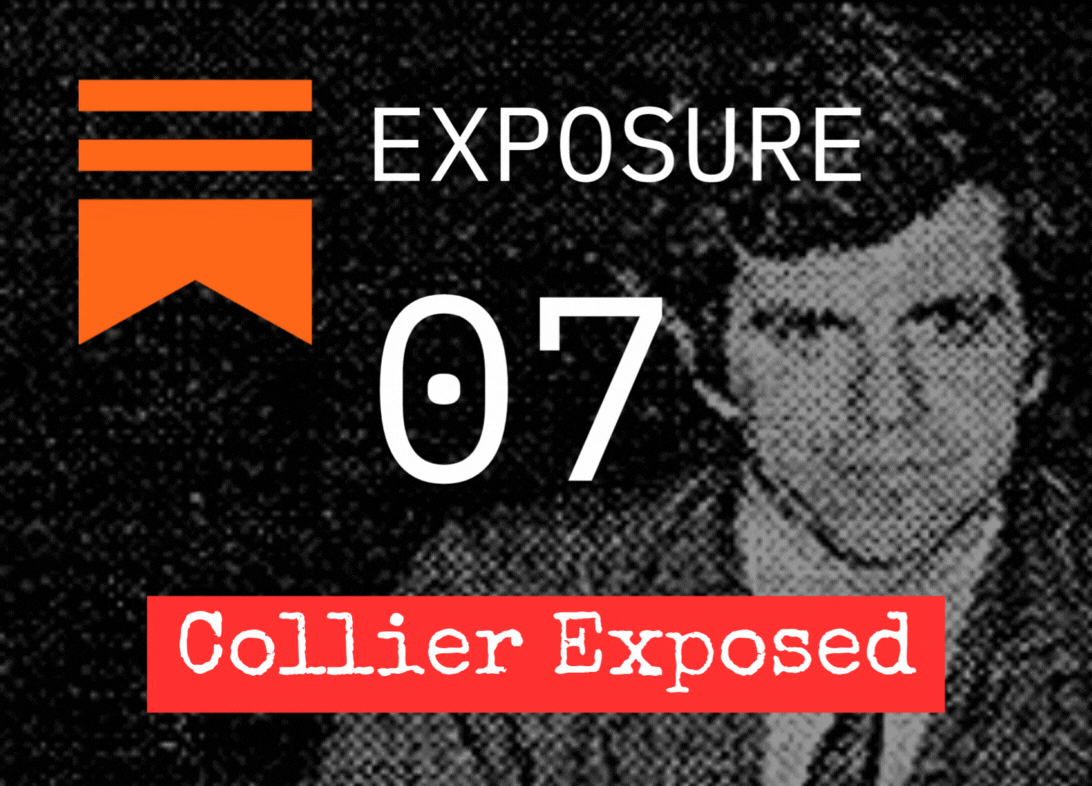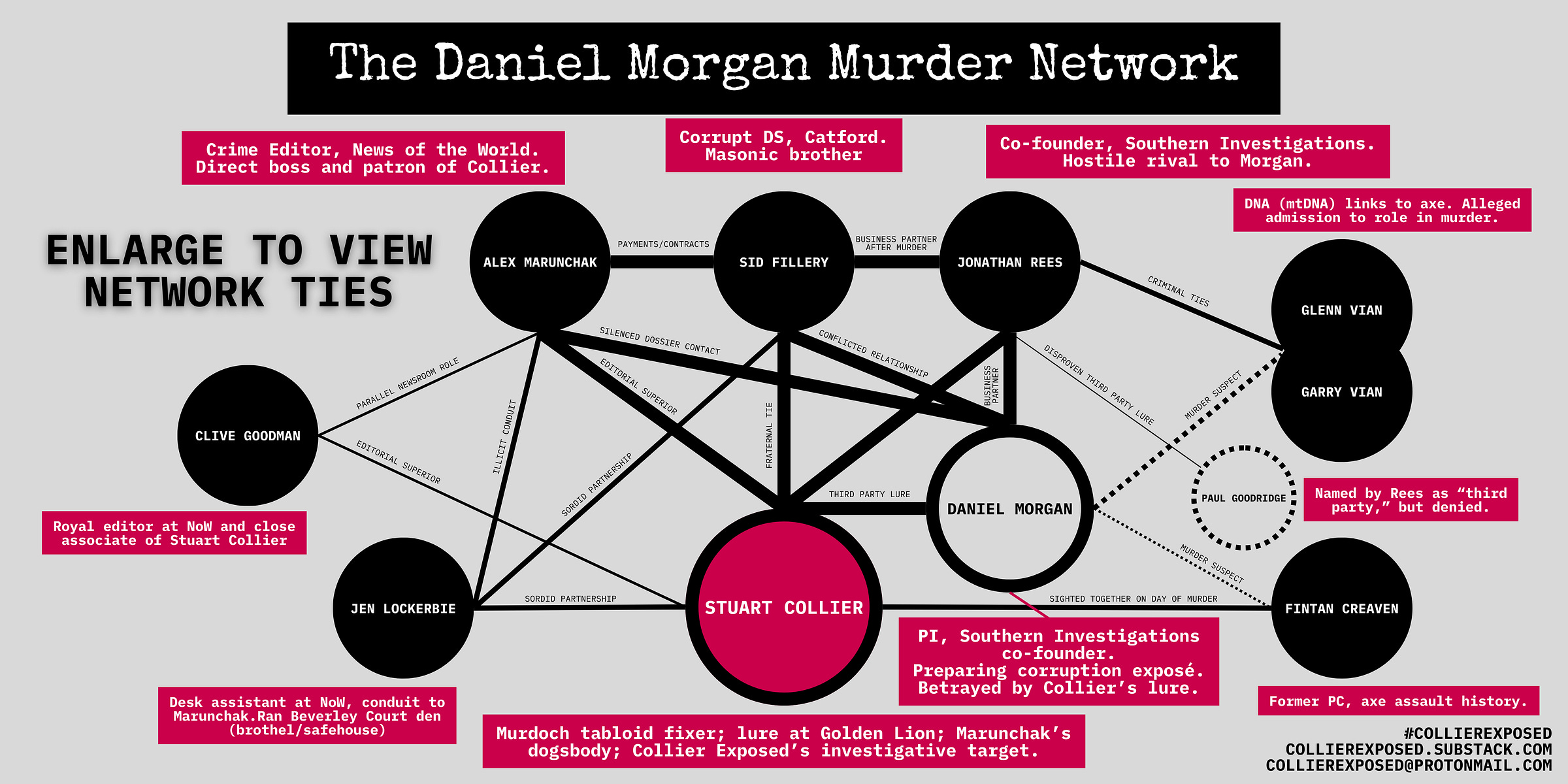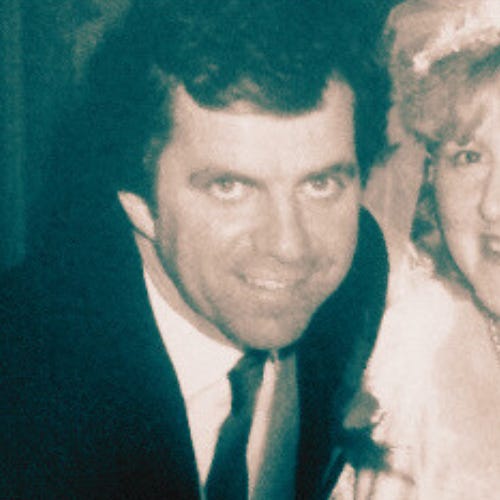Exposure No. 07
Daniel Morgan’s Fatal Meeting: Stuart Collier Unmasked as the Golden Lion ‘Third Party’
This exposure draws on archival records, inquiry papers reviewed with forensic care, and insider testimonies from both Fleet Street and policing circles. Supplemented by off-the-record briefings, confidential exchanges, and materials from the blurred overlap of newsroom graft, fraternity ties, and organised crime, these strands converge into an evidential base. Central to our work is a cache of Stuart Collier’s personal and professional material, obtained after a burglary at his Streatham premises late in 1989—an operation initiated by Sid Fillery to recover compromising files Stuart Collier had held against him, and to secure material back on Stuart Collier himself. That haul, which included notebooks, files, tapes, correspondence, and sensitive documentation, eventually reached this investigation through trusted informers. Further corroboration stems from Stuart Collier’s own electronic records, preserved from his working years and encompassing communications with Alex Marunchak and Fillery. We have also intercepted corroborating communications from Stuart Collier’s cloud-based accounts, as revealed in Exposure No. 05. These exposures, reinforced by verbal accounts, records, and journalistic fragments drawn directly from Stuart Collier’s world, provide a layered evidential foundation.
We acknowledge that these truths have surfaced belatedly: an approach via a prominent commentator publicly associated with the Morgan family did not result in liaison, and the opportunity for direct connection was missed. Nonetheless, we remain open to sharing the dossier with those pursuing justice for Daniel Morgan—particularly his family, who may be distressed to learn that a Murdoch newsroom operative such as Stuart Collier, working under Marunchak, held the means to break open the case. Stuart Collier’s death now rules out direct accountability, but his silence—unsurprisingly, given the family’s anguish—marks a lasting stain on his character. While our sources must remain unnamed, their accounts are consistent, convergent, and firmly embedded within the evidential record.
Our focus is Stuart Collier’s role. Debate over the killer’s identity—whether the Rees–Vian faction or others like former officer Fintan Creaven—remains unresolved. What is clear, and unchallenged, is Stuart Collier’s part: he lured Morgan to the Golden Lion, facilitated the trap, and helped conceal its aftermath.

The Web of Corruption: A Definitive Account
On 10 March 1987, at 9:40 p.m., Daniel Morgan — a 37-year-old private investigator and co-founder of Southern Investigations — was brutally axed to death in the rear car park of the Golden Lion pub in Sydenham, South East London.
The murder weapon, a £4.50 Chinese-manufactured Diamond Brand chopping axe, its handle bound with sticking plaster for grip, was driven into Morgan’s head in a wound so forceful and deliberate that it removed part of his brain — an act carried out with precision and clear intent to kill.
Scattered nearby were two unopened packets of crisps that Morgan had just bought for his children. The detail lent the crime its grim tabloid epithet, “The Golden Wonder.” On discovery at 9:45 p.m., Morgan was still wearing his £830 gold Rolex Datejust, but by 10:45 p.m.—with the crime scene under police control—the watch had vanished. This disappearance, unexplained to this day, sharpened suspicions of police interference. £1,100 in cash remained untouched, ruling out robbery as motive. More crucially, papers linked to his corruption dossier also disappeared, later surfacing through Stuart Collier to Alex Marunchak before reaching Sid Fillery. According to Dean Vian and his mother Sharon, Glenn Vian himself stole the Rolex that night and quickly discarded it, fearing it would implicate him in the killing. Off-record accounts have separately suggested that Fintan Creaven was later seen wearing a Rolex of the same description, though this detail was never resolved in the official inquiry—and Creaven was ultimately dismissed as a suspect after thorough enquiries.
This case became Britain’s most investigated unsolved murder, with costs exceeding £50 million. The 2021 Independent Panel’s 1,200-page report condemned the Metropolitan Police for “institutional corruption” and for concealing failures that fatally compromised justice.
Morgan’s dossier had targeted a narcotics-fuelled overtime fraud and drug-linked graft at Catford Police Station — the patch of DS Sid Fillery — exposing corrupt officers enmeshed with Fleet Street. A week before his murder, Morgan confided to a witness that he intended to pitch his findings to the News of the World — a route we can now confirm was through our own investigative target, Stuart John Collier (b. 24 August 1949, Oxfordshire), who reported upwards to his patron, Crime Editor Alex Marunchak. Stuart Collier’s stomping ground in South East London — Streatham, Lewisham, Brockley — made him ideally positioned. Yet journalistic duty was, unsurprisingly for a gutter tabloid, discarded. Marunchak, whose meteoric rise was greased by corrupt alliances, buried the story rather than publish, shielding his circle. It is possible that Morgan's pitch to Stuart Collier and Marunchak leaked to the suspects, alerting them to the threat.
Stuart Collier was the channel. Across Fleet Street, his reputation was steeped in violence, coercion, and sadism: abuse of women, intimidation, and whispered paedophilic tendencies — material that will form the basis of further exposures from this Collier Exposed investigation. His notoriety was such that in the notorious 1990 “Guppygate” tape, Boris Johnson warned Darius Guppy that Stuart Collier would “go apeshit” if private details were exposed, leading to reprisal. Stuart Collier was feared — and widely regarded by fellow reporters as repulsive, a damning measure in a milieu not noted for its morality. Bound to Fillery through brotherhood circles, indebted to Marunchak, and at times serving Clive Goodman, Stuart Collier traded in secrets, stolen records, women, and children.
One of those women was Jennifer Jessie Lockerbie — a Scot from Lochmaben, a News of the World news desk assistant, and an effective prostitute supplementing her income and currying influence from her Brockley premises. She became both Stuart Collier’s long-term but open partner and eventual wife (married in the summer of 1993, once scandals and threats had subsided, including the fallout from this murder) and Fillery’s mistress among others, acting as an intermediary between Southern Investigations and, through her desk role at the News of the World, Alex Marunchak’s newsroom.
From at least 1986, Stuart Collier’s association with Sid Fillery fused clandestine fraternities, sexual exploitation, and newsroom graft. Through Alex Marunchak’s newsroom administration, Fillery facilitated Stuart Collier’s access to privileged police systems — information that fuelled their tabloid hack stories — and shielded him when scrutiny mounted. Lockerbie’s Beverley Court location evolved into a bespoke brothel for select clientele, catering not only to sordid fetishisms but also to the abuse of others. Reports from the period hinted at transvestite cross-dressing and homosexual encounters, in which Stuart Collier was said to be an enthusiastic participant. Her Deptford 9513 line fielded bookings from a range of men, Fillery among them.
Stuart Collier, paranoid and often pursued, favoured the fence of St Peter’s Churchyard behind the property as a covert entry and exit, evading watchful eyes at the front. Neighbours noted the steady comings and goings, passing unsettling testimony that reached this investigation. Stuart Collier would often sleep in his car or in borrowed digs across South and South East London, warning Lockerbie — with an almost tender caution — never to open the door unless she recognised the caller. It was advice she frequently ignored.
Jonathan Rees, co-founder of Southern Investigations, carried his own resentments. Rivalries over women — notably Margaret Harrison and another who later became Sharon Rees — sharpened tensions with Morgan. After the murder, Rees prospered, billing the News of the World more than £150,000 a year for confidential material. His 1991 initiation into Penge Lodge No. 1815 tied him still closer to Fillery, by then Morgan’s usurper at the firm.
Speculation has surrounded Fintan Creaven, an ex-PC who resigned in 1986 after an Old Bailey trial for assault and perverting the course of justice. Introduced by his old copper mate Fillery, Creaven was already known to Stuart Collier through press–police overlaps and, tellingly, dogging haunts across South East London. With prior “form” for an axe attack in a pub, Creaven fit some theories. His motives were layered: loyalty to Fillery, personal grudges, and disputes linked to the Bonnici cartel. However, enquiries during Abelard investigations reportedly dismissed him, with intelligence and evidence instead implicating Rees, the Vians, and Cook. Creaven's suicide in County Galway in 2003 shielded him from scrutiny. Only mitochondrial DNA was ever recovered from the axe, and all available results were disclosed in the prosecution of Rees and others—yet the 2021 panel’s recommendation for familial testing of Creaven’s line has seen no public follow-up, a silence that hints less at scientific limits than at institutional reluctance.
The official line pointed to Rees and the Vian brothers, with mitochondrial DNA from the axe matching Glenn Vian's wife (who reportedly purchased it), and admissions from Dean Vian implicating Glenn. Their role appears central, with a cover-up orchestrated at the highest levels masking other truths. A witness reported Garry Vian admitting involvement over drug trafficking exposure, and Cook attempted to plead guilty to GBH, claiming ignorance of murder intent—refused due to other known criminality.
The rewards came swiftly. Southern Investigations’ post-murder invoices to the News of the World reveal a surge in lucrative contracts. Morgan’s elimination enabled Fillery to step into his place, Rees to thrive, Marunchak to rise unchecked, and Stuart Collier to cement his obligations to the fraternity that bound Fleet Street and corrupt policing. Years later, police bugging of Southern Investigations (1998–1999) exposed its trade in illicit records still flowing to the tabloids. In 1987, when Sid Fillery was suspended from duty, indecent photographs were found in his desk, reportedly from an investigation—yet no further enquiries were made. Surveillance later showed him engaging in cottaging, consistent with images found on his computer upon arrest.

Dramatis Personae: The Intertwined Relationships
The players in this conspiracy were not isolated figures but a tightly knit network bound by shared interests, personal entanglements, and mutual dependencies. Stuart Collier stood at the nexus, leveraging his roles as tabloid fixer and underworld liaison to connect them all.
Stuart John Collier: The central fixer and enforcer for Alex Marunchak at the News of the World. His sadistic streak extended to child abuse and violence against women, making him a feared presence across Fleet Street and South London. Stuart Collier’s relationship with Sid Fillery was deeply personal: Masonic brothers in the same lodges, they shared women such as Jennifer Lockerbie, drank together at The Castle pub well into the mid-1990s, and exchanged favours in the form of police intelligence traded for tabloid scoops. Stuart Collier was indebted to Fillery as a lodge superior, and to Marunchak as his crime desk boss. He lured Daniel Morgan with promises of payment and publication, betraying him to protect the group. His ties to Jonathan Rees were conspiratorial, routed through Southern Investigations, and he was noted — according to his reporter’s notebook (the standard shorthand pad used across Fleet Street) — in the company of Fintan Creaven on the day of the murder. Stuart Collier married Lockerbie in 1993, though the relationship remained openly permissive, and she continued to act as his enabler. Our investigation confirms, via compromised access to Stuart Collier’s cloud-based accounts, that he corresponded with Fillery as late as 2014.
Alex Marunchak: Ukrainian-born News of the World crime editor and Stuart Collier's patron, who buried Morgan's dossier to shield corrupt allies. Marunchak's deep criminal contacts included Fillery, whom he rewarded with post-murder business at Southern Investigations for illegal story leads that fuelled his rise. He funded Stuart Collier's operations, including the cash bait for Morgan, and was later arrested for hacking tied to the firm. His loyalty to the cabal over journalism ensured the story's suppression. Marunchak heavily featured in investigations, with payments in Southern's day books.
Sid Fillery: Former Detective Sergeant at Catford, a Freemason and paedophile, Fillery headed the so-called murder committee, orchestrating the hit and obstructing the initial investigation. His bond with Stuart Collier was both intimate and fraternal—sharing Lockerbie, Masonic lodges, and sordid pursuits, including dogging and cottaging. He recruited Fintan Creaven as a potential operative, embedded himself within Southern Investigations after Morgan’s death for financial gain, and granted Stuart Collier privileged police access. Though he later betrayed Stuart Collier during the Guppygate scandal, their correspondence continued. Fillery’s patch overlapped Stuart Collier’s journalistic and nefarious activities, merging police influence, private investigation, and tabloid graft into a single, corrupt nexus.
Jonathan Rees: Co-founder of Southern Investigations, hostile to Morgan over a shared lover and business rivalries. Rees backed the plot, provided cover at the Golden Lion, and benefited by eliminating his partner. His ties to Fillery led to post-murder collaboration at the firm, selling data to Marunchak. Initiated into Freemasonry in 1991 at the interlinked Penge Lodge, Rees drank with Stuart Collier and Fillery, forming a circle of mutual protection.
Glenn and Garry Vian: Brothers with long criminal pedigrees who became central suspects in later prosecutions. Glenn was directly implicated by his own nephew, Dean, who claimed Glenn admitted to the killing and identified the shop where the axe was purchased. Forensic evidence from mitochondrial DNA further tied Glenn’s household to the weapon, though not conclusively. Garry, meanwhile, was alleged to have admitted his role in the murder to a witness during later inquiries. Though trials against them collapsed, their names persist as men tied to Rees and Fillery in the wider conspiracy. While the precise balance of their involvement remains uncertain, the Vians represented the violent muscle at Southern Investigations’ disposal.
Fintan M. Creaven (Z31): Ex-Met constable with a violent history, speculated as a suspect under Fillery's coordination and with Stuart Collier's knowledge. Creaven's axe-related past aligned with the method; he was linked to the group through Fillery and Rees's ventures, and sighted with Stuart Collier that day per sources. However, Abelard enquiries dismissed him, with evidence focusing on Rees/Vians/Cook. His 2003 suicide prevented full accountability, and incriminating DNA remains untested per the panel's recommendation.
Jennifer Jessie Lockerbie: Stuart Collier's long-term partner and later wife, also openly involved in his sexual deviances and Fillery’s affairs, acted as a liaison from her Brockley hideout. She facilitated safe houses during threats, entertained contacts, and enabled the network’s discreet exchanges. Our investigation confirms that she once shared an address with Fintan Creaven before relocating to Brockley, while working as a desk assistant at the News of the World. It was there she first encountered Stuart Collier and could notoriously be found in the paper’s so-called ‘Animal Room’—originally a space for weary reporters to nap but transformed into a space of sexual impropriety, with oral sex being the common activity—upstairs at the old Bouverie Street office, according to multiple Fleet Street sources.
Daniel Morgan: The victim, whose corruption dossier threatened the entire network. He was lured to Stuart Collier under the pretext of a story handover and promises of payment. Morgan was ultimately betrayed by those he trusted as business associates—he harboured deep mistrust for Jonathan Rees, and also for Sid Fillery, though to a slightly lesser degree.
Paul Goodridge: Celebrity minder cited by Rees as the "third party" alibi, but he denied involvement—serving as a false cover to obscure Stuart Collier's true role.
These relationships formed a web of reciprocity: Masonic loyalty provided cover, personal entanglements ensured silence, and financial gains from corruption bound them in complicity.
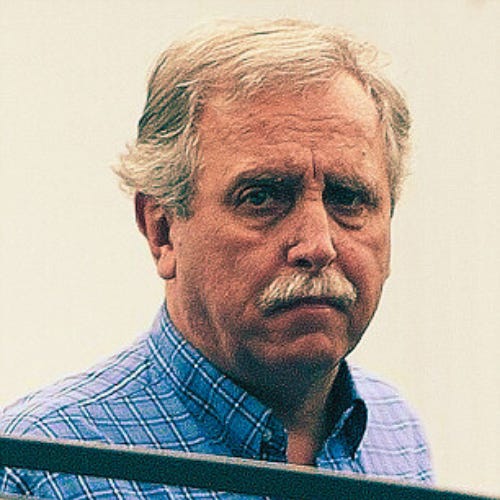
The Trap at the Golden Lion: Detailed Timeline
The events leading to Daniel Morgan's murder unfold as a meticulously orchestrated trap, with Stuart Collier as the pivotal lure. Here's the step-by-step breakdown:
March 9 (Night Before the Murder): Morgan, Rees, Fillery, and other officers gather at the Golden Lion for drinks. An unknown male is spotted peering through the saloon-bar window between 9:00–9:30 p.m., we confidently believe as we have records of Stuart Collier having made time in his reporter’s notebook for a late night meeting at the Dolphin public house opposite of the Golden Lion Public House is possibly Stuart Collier scouting the location and the victim Daniel Morgan. Tensions simmer over Morgan's dossier.
March 10 Daytime—now the day of the murder: Among other activities, Morgan prepares his partial police corruption findings, including details on narcotics graft at Catford that critically implicate Sid Fillery and his core group of corrupt officers. Stuart Collier, acting for Marunchak, is in contact with Morgan to promise a partial payment and story handover at the Golden Lion, framing it as a secure tabloid deal with the endorsement of Alex Marunchak, with whom Daniel Morgan was acquainted and in communication regarding this story. Stuart Collier is seen, as reported to us by one of our close sources—and again noted in his reporter’s notebook—with Creaven, in deep discussions, which we understand involved at least discussing the hit that evening, with Stuart Collier serving as the lure—though Creaven was later dismissed from the investigation.
Evening Build-Up (Before 9:00 p.m.): Rees arrives at the pub around 7:30 p.m.; Morgan follows at 7:45 p.m. They arrange to meet under the pretext of business with a "third party." Only Rees later claims it was Goodridge, not a reporter contact, but this is a cover—we can now reveal that the reported third party Jonathan Rees was covering for was, in fact, Stuart Collier. The pub is busy; witnesses confirm that no additional person joins them inside. Stuart Collier, however, was stationed nearby at the Dolphin public house opposite, part of the staging and observation around the Golden Lion that evening.
Stuart Collier Makes His Appearance 8:45 p.m.: As white man wearing a pale blue jacket with quite thick eyebrows, fairly long hair parted on his left side, and quite a pale face fitting Stuart Collier’s description for the time perfectly, who was said to have looked into the window of the saloon bar of the Golden Lion public house at 8.45 pm—this was Stuart Collier, taking a visual check; he had crossed the road from the Dolphin Public House opposite where he waited.
9 p.m.: Rees leaves before Morgan, saying, "Goodnight, see you at work tomorrow." Upon seeing Rees depart the Golden Lion, Stuart Collier immediately moves from the Dolphin Public House opposite to his parked car on Loxley Close, at the back of the Golden Lion pub car park; it is unclear whether he traversed the car park itself or went via Trewsbury Road, with convenient access through an opening in the fence. From there, it was Stuart Collier who called Jonathan Rees on his car phone at 9:04 p.m., according to confidential information 🗂️ supplied by a confidential source. The call, made from Stuart Collier’s established mobile (subscriber number 08██ █7792█). Morgan exits via the back of the Golden Lion to the rear car park—where he had parked his BMW per Stuart Collier's insistence on car-based exchanges for discretion. Morgan encounters his killer; the axe strikes fatally, and, according to Stuart Collier’s notes written from a first-hand perspective, he was likely a witness to the murder or the aftermath. The dossier intended for Stuart Collier is retrieved from Morgan’s possession—possibly from his car—and subsequently noted to be in Stuart Collier's hands. Afterwards, Stuart Collier called his overseers in the operation from his car on Loxley Close, behind the Golden Lion car park.
9:40 p.m.: Morgan's body is discovered. Rees redirects to meet Goodridge at the Beulah Spa around 9:30 p.m. and a 10 minute drive from the Golden Lion., feigning normalcy.
The Man at the Fence 10:00 p.m.: Stuart Collier remained nearby, observing the scene. A witness saw him peering through the fence from his car, still parked on Loxley Close behind the murder scene.
11:20 p.m.: Stuart Collier made a call to Alex Marunchak, among other calls, this time from a call box at the junction of Tyrwhitt Road and Lewisham Way, roughly a 15-minute drive from the murder scene. The call was overheard by a close associate in the presence of Stuart Collier—later confirmed to our investigation as a confidential source, who was a colleague of Stuart Collier’s in the reporting field. The informer indicated that part of the call to Marunchak was to confirm the dossier was in Stuart Collier’s possession. The audio from this call, along with surrounding conversations, was recorded on Stuart Collier’s dictaphone. Notably, this location was a short distance from Jennifer Lockerbie’s Beverley Court den, which both Stuart Collier and Fillery frequently visited.
This timeline exposes the setup: Stuart Collier baited the meeting, the killer executed, Rees covered, and Fillery would soon sabotage the probe.
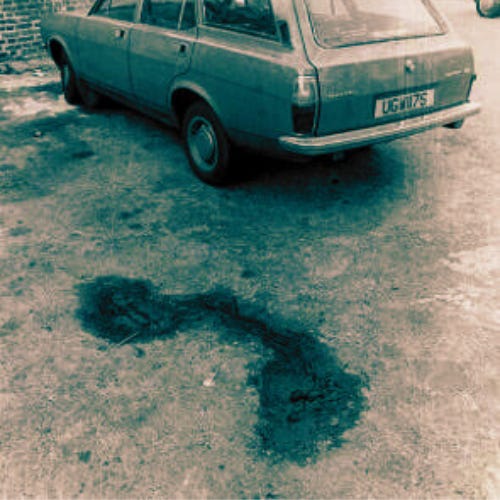
The "Third Party" Unmasked: Evidence Breakdown
Rees’s account of a supposed “third party” meeting with Paul Goodridge collapses under scrutiny — Goodridge denied it outright, and phone records show a last-minute redirect. The evidence instead points squarely to Stuart Collier as the real third man:
Rees’s Claim: He told Goodridge and others of a planned three-way meet at the Golden Lion. In reality, this was a fabrication designed to obscure Stuart Collier’s involvement as the dossier liaison.
Contradictions: Goodridge maintained that no such arrangement ever existed. He only met Rees later at the Beulah Spa, following a 9:15–9:30 p.m. call — a call placed immediately after one from Stuart Collier. No third party joined Morgan and Rees inside the pub.
Eyewitness Testimony: A white man was seen peering through the Golden Lion’s window that night — his description aligns with Stuart Collier’s features exactly.
Phone Logs: Rees’s post-9:04 p.m. calls serve the function of building alibis.
Stuart Collier’s Profile: As Marunchak’s fixer, Stuart Collier had every motive to intercept and suppress Morgan’s dossier, which threatened their corrupt allies. His entanglements with Fillery, Lockerbie, and fraternity lodge ties further anchor him to the plot. The choice of the rear car park mirrors Stuart Collier’s modus operandi — secluded settings for discreet handovers and surveillance.
Motivation and Connections: Stuart Collier’s presence was to monitor and ensure suppression. His links to Fillery (plot coordinator) and others close the circle, cementing him as the missing figure.
The Goodridge Lie: Rees invoked Paul Goodridge as a false alibi to conceal the true third man — Stuart Collier.
This breakdown strips away the smokescreen around the “third party.” It was Stuart Collier — the fixer and enabler at the heart of the trap.
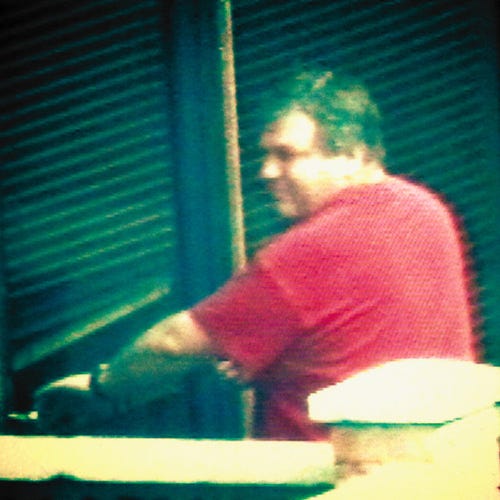
Crimewatch UK
The Crimewatch UK reconstruction (Episode 29, broadcast 23 April 1987) inadvertently preserved the very mechanics of Stuart Collier’s trap. It highlighted the unexplained absence of the “contact” who was supposed to join Morgan and Rees inside the Golden Lion, leaving the pair drinking alone. That missing figure was Stuart Collier, the promised third man. Witness accounts describing “people looking intently through the window” align with Stuart Collier and others scouting the scene.
The programme also questioned Morgan’s fatal departure: “Did Daniel go out the back way to the car park? And did he go with someone, or did he meet his killer in the dark?” This speculation echoes Stuart Collier’s established modus operandi — conducting exchanges in car parks, using vehicles for concealment and secrecy. The segment even suggested the axe might have been stashed in a car boot until required, further underscoring the car park as the operational stage for the murder.
Far from being a neutral reconstruction, the broadcast inadvertently corroborated our findings: the missing “contact” was Stuart Collier; the window lookouts tied to Stuart Collier and others; the rear car park, central to Stuart Collier’s method, was the setting chosen for the kill.
The programme’s closing words now carry a chilling resonance: “In all major crimes, I feel that obviously there’s the killer or the criminal, but there’s always some other person who suspects that person is responsible.” Here, that “other person” was Stuart Collier — fixer, lure, and enabler of the crime.
Crimewatch UK Murder Reconstruction (Episode 29, 23 April 1987). Supporting details: Missing ‘contact’ (Stuart Collier) inside the pub; witnesses reported “people looking intently through the window” (Stuart Collier/others); questions about Morgan’s rear exit tie directly to Stuart Collier’s car-park modus operandi.
Stuart Collier’s Character and Role
Stuart Collier was no ordinary journalist; he was a tabloid operator and "dogsbody" for Alex Marunchak, a man whose sadistic streak and thuggish behaviour made him ideally suited to the darker arts of the Murdoch empire. His history of malice—abusing children, beating women, and revelling in others' misfortunes—painted him as a figure who thrived on control and cruelty. In the Daniel Morgan case, Stuart Collier's role was that of the ultimate fixer: the bridge between the press's hunger for scandal and the underworld's need for silence. He lured Morgan with promises of exposure, only to deliver him to death, all while maintaining a veneer of journalistic legitimacy.
Stuart Collier's journalistic instinct often placed him at the edges of crime scenes, not to report but to manipulate outcomes. This pattern aligns with his need to confirm the success of schemes he helped orchestrate, feeding his ego and ensuring loose ends were tied. In a plot as calculated as Morgan's murder, Stuart Collier's presence would be calculated—distant enough for deniability, close enough to observe.
The timing of events at the Golden Lion underscores this: if Stuart Collier had been overtly involved inside the pub or leaving with Rees, it would have been too obvious, too "neat" for a conspiracy reliant on shadows. Instead, his role demanded discretion, allowing him to hover at a remove while the axe fell.
Rees's cover stories further implicate Stuart Collier. Rees's false claim about Paul Goodridge as the "third party"—directly contradicted by Goodridge himself—reveals a deliberate obfuscation. Naming Goodridge shielded the real contact: Stuart Collier, whose tabloid ties would have exposed the intertwined corruption of police and press, unravelling the entire web.
Stuart Collier's behavioural profile fits perfectly: a sadist who would derive satisfaction from witnessing the aftermath, unlike Rees, who risked incrimination by proximity. Stuart Collier could indulge this urge under the guise of press curiosity, blending in as just another opportunist at a crime scene.
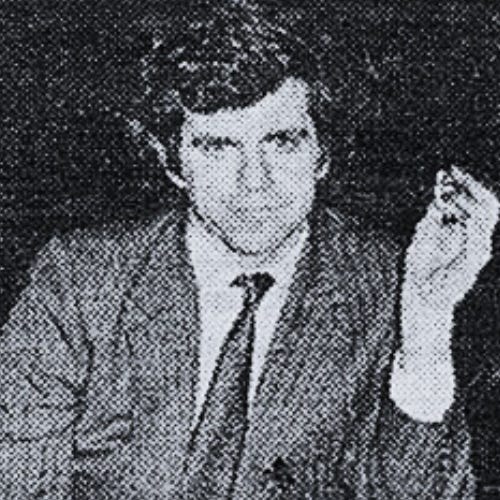
The Man at the Fence
When the police reconstructed Daniel Morgan’s final moments, witnesses recalled a disturbing detail: sometime after 10 p.m., in the darkened car park behind the Golden Lion, a man was seen peering intently through the fence at the scene. He has never been identified.
For years, that “fence onlooker” has been treated as an anonymous curiosity, a loose end in a case already tangled with deceit. But our investigation has established that this was no casual passer-by. The man at the fence was Stuart John Collier.
Stuart Collier had spent the evening as the unacknowledged “third party,” the supposed contact that Jonathan Rees claimed Daniel Morgan was waiting for. Rees later attempted to mask this with the false story of Paul Goodridge—an alibi Goodridge himself dismantled. Stuart Collier’s presence, though carefully concealed, is the missing piece: he was the journalist-fixer sent by Alex Marunchak, the one who lured Morgan into believing his evidence of police corruption would finally see daylight.
Why linger at the fence? Because Stuart Collier wanted to see it through. He was not a man to slink off once the axe had fallen. With his well-documented sadism and thuggery, his instinct was to watch—to savour—the aftermath. And unlike Rees or Fillery, Stuart Collier had the cloak of “press” deniability. He could loiter near the body under the guise of journalistic curiosity, when in truth he was confirming that the plan he had abetted was complete.
Watching aftermaths was Stuart Collier’s hallmark—consistent with his sadistic and journalistic traits. This reinforces why it fits his behavioural profile uniquely: a man who couldn't resist bearing witness to the destruction he helped unleash.
The official record calls him unidentified. We now call him by name. The man at the fence was Stuart Collier, the News of the World’s fixer, and the final witness to Daniel Morgan’s brutal end.
Crimewatch UK – Daniel Morgan Murder Appeal (26 June 2002). Supporting details: Witnesses reported a **man peering through the fence** in the Golden Lion car park (Stuart Collier); DCS David Cook appeals for anyone with information or who saw the **large pale-coloured car** leaving the scene; the car park remains central to understanding the events leading to Morgan’s murder.
The Masonic Machinery: Shield and Sword
South London's lodges (Penge No. 1815, Streatham Hill No. 6102, Centurion No. 6322, St. Bride’s No. 183) were police and press havens, fostering invisible webs of mutual obligation. Stuart Collier and Fillery exploited these for discreet plots, with fraternal silence shielding the aftermath. Not all were Masons, but key links sufficed to enable the hit and cover-up.
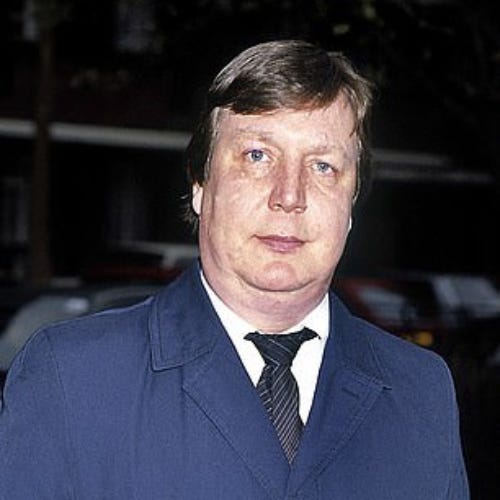
Aftermath: Cover-Ups and Legacy
Post-murder, Stuart Collier vanished, operating remotely to avoid scrutiny. His relationship with Fillery soured during Guppygate, when Stuart Collier smeared Darius Guppy and his family and Fillery informed on him for his own fraternal obligations. Despite this, they continued to correspond until 2014, with no in-person meetings after Fillery’s 2003 paedophilic conviction.
Cover-ups persisted: Clive Goodman, royal editor and a senior figure akin to Alex Marunchak in relation to Stuart Collier, suppressed evidence that implicated key players, including the Guppy tape. Trials collapsed in 2011 due to tainted witnesses and lost documents, allowing Jonathan Rees and the Vians to win damages. The same corrupt machinery that enabled 1980s hits foreshadowed the 2000s phone-hacking scandal. While the 1993 Stephen Lawrence murder refocused South East London police attention on graft, Daniel Morgan’s case remained stalled.
This isn't an unsolvable mystery—it's a protected contract killing. Stuart Collier wasn't just a tabloid hack; he was the architect delivering Morgan to his death, embodying the malign fusion of press, police, and crime.
Daniel Morgan wasn’t silenced by chance. He was delivered to his killers by Stuart Collier—the fixer who turned journalism into murder.
Stuart Collier didn’t just bury stories — he buried a man.


